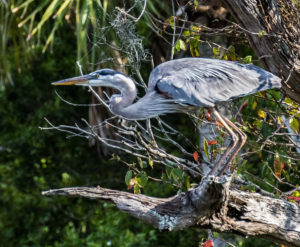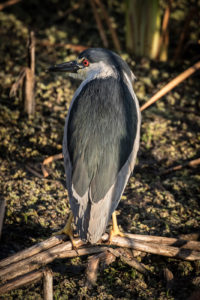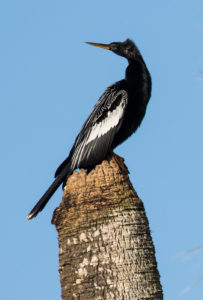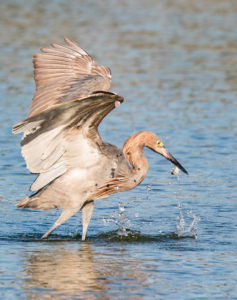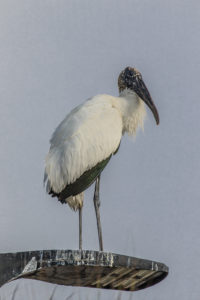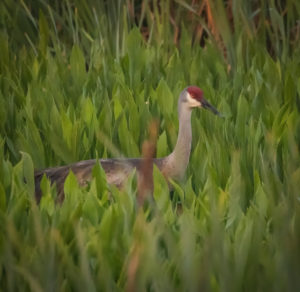Sherm Edwards
My grandfather, who lived next door until his death when I was about 8 and for whom I was named, had several hobbies about which he was passionate. Two were photography and bird watching. His favorite photographic medium was stereoscope slides, two positive images encased in a rectangular frame projected onto a screen or looked at through a viewer to produce a three-dimensional effect. I have a few of his slides of family events and a viewer, but remember vividly his slides of evening grosbeaks at a feeder outside of his front window.
He did what he could to encourage me in his passions, especially bird watching. He gave me books by Thornton W. Burgess, who anthropomorphized animals and birds in stories for children, and more serious books of birds. My parents also fed birds in our yard. I enjoyed watching the chickadees, nuthatches, and other New England birds that came to our feeders, and helped to discourage the squirrels who came for their share. I enjoyed Burgess, and became familiar with a variety of species, but birding didn’t become the passion my grandfather might have hoped.
Flash forward 60 years or so, and photography has become one of my main avocations. Until recently, I hadn’t taken on photographing birds too seriously, thinking it required too much patience, better equipment than I owned, and techniques I hadn’t learned. In 2018, I attended a fall color workshop in Michigan’s Upper Peninsula with John Gerlach and Barbara Eddy (www.gerlachnaturephoto.com). A feature of their workshops is John’s idiosyncratic classroom presentations, often featuring techniques somewhat out of the mainstream. My first workshop with them had presentations on using flash in nature photography and focus stacking. At the fall color workshop, he did a presentation on photographing birds (which really had nothing to do with the workshop), and gave us his detailed notes on his technique. He made it seem not so esoteric, quite doable, even.
Armed with this information, I decided to try a bird photography workshop, so signed up for one with Jennifer King (www.jenniferkingphoto.com), with whom I had done several other workshops; it was scheduled for March 2019 on and around Merritt Island in Florida. The accompanying photos are all from the workshop.
A new photographic subject means an excuse to buy new equipment, of course. I scoured the Internet for “best cameras for photographing birds.” I learned that one of the main criteria was the number of frames per second the camera could manage. As a Canon guy, I was somewhat surprised to learn that one of the favored cameras was the 7D Mark II, with a crop frame sensor and the ability to shoot 10 frames a second, more than 3 times the speed of my more expensive 5D Mark III. It was also the cheapest of the recommended cameras in most lists, by a lot. After some vacillation, I picked up a used 7D body at District Camera and paired it with my 100-400mm f4.5-5.6 and a 1.4x tele-extender. Combined with the crop frame, this pairing gave me a maximum of almost 900mm equivalent.
One of the pieces of equipment Jennifer recommended was a gimbal head; more research showed that a Wimberley head would be the way to go, but I balked at the $500-$600 that would set me back. I finally decided on a Wimberley Sidekick, at about half the price, which attaches to a ball head. You then use the ball head for horizontal movement and the Sidekick for vertical movement. (It’s easier than it sounds.) But, I have found that mostly I am shooting birds in flight handheld. The jury is still out on the Sidekick.
I also read a lot of advice about camera settings. Shooting a heron standing in a pond is pretty much like shooting a landscape, but birds in flight are a completely different story. Everyone agrees that fast shutter speeds (1/1000 or higher) are essential and AI Servo (Canon’s continuous focus setting) works best, and most agree that full manual mode is too cumbersome. A majority, including Jennifer King, seem to favor aperture priority. John Gerlach, though, recommended manual mode with auto-ISO. I tried out this approach and was pretty much instantly comfortable with it. It doesn’t work so well in low light, though, as the camera maxes out around 3600 in auto ISO, and even that speed may be too grainy for many tastes.
The Florida workshop was a lot of fun, and I got good pictures of osprey, various herons, and other shore birds. I have also been to Blackwater and Bombay Hook National Wildlife Refuges, both excellent locations for birds about 2 hours from Silver Spring. My favorite local spot for birds is Huntley Meadows Wildlife Refuge, which I first visited on an SSCC field trip.

